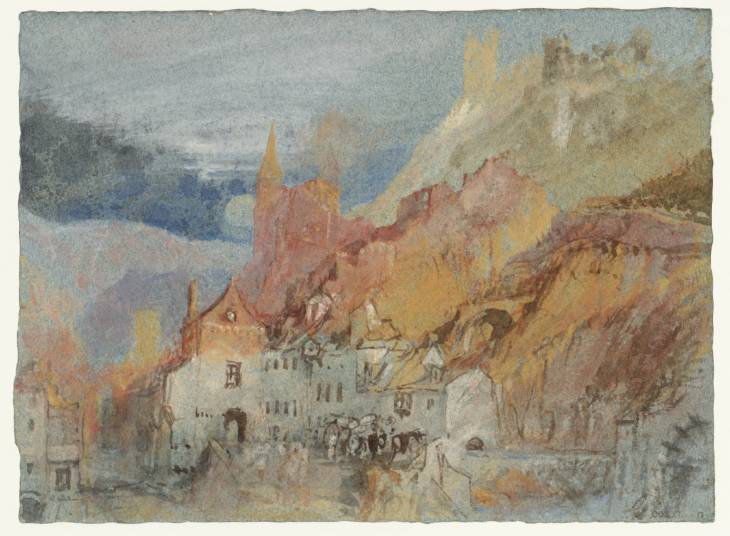Joseph Mallord William Turner The Entrance to Trarbach from Bernkastel c.1839
Joseph Mallord William Turner,
The Entrance to Trarbach from Bernkastel
c.1839
Joseph Mallord William Turner 1775–1851
The Entrance to Trarbach from Bernkastel c.1839
D20240
Turner Bequest CCXXI G
Turner Bequest CCXXI G
Gouache and watercolour on blue wove paper, 141 x 191 mm
Blind-stamped with Turner Bequest monogram bottom right
Stamped in black ‘CCXXI–G’ bottom right
Blind-stamped with Turner Bequest monogram bottom right
Stamped in black ‘CCXXI–G’ bottom right
Accepted by the nation as part of the Turner Bequest 1856
Exhibition history
1904
National Gallery, London, various dates to at least 1904 (180, as ‘Bacharach’).
1959
Turner Watercolours from the British Museum, Luxembourg State Museum, June–July 1959 (no catalogue).
1984
J.M.W. Turner in Luxembourg and its neighbourhood, Musée de l’Etat, Luxembourg, March–April 1984 (39, reproduced as Vue de Traben-Trarbach (Moselle)).
1991
Turner’s Rivers of Europe: The Rhine, Meuse and Mosel, Tate Gallery, London, September 1991–January 1992, Musée Communal d’Ixelles, Brussels, February–April 1992 (58, reproduced, and in colour [p.73]).
1995
Turner in Germany, Tate Gallery, London, May–September 1995, Städtische Kunsthalle Mannheim, September 1995–January 1996, Hamburger Kunsthalle, Hamburg, January–March 1996 (48, reproduced).
1998
Moonlight and Firelight: Watercolours from the Turner Bequest, Tate Gallery, London, July–November 1998 (9, no catalogue).
References
1904
E.T. Cook and Alexander Wedderburn eds., Library Edition: The Works of John Ruskin: Volume XIII: Turner: The Harbours of England; Catalogues and Notes, London 1904, p.615 no.180, as ‘Bacharach’.
1909
A.J. Finberg, A Complete Inventory of the Drawings of the Turner Bequest, London 1909, vol.II, p.688, as ‘Bacharach’.
1991
Cecilia Powell, Turner’s Rivers of Europe: The Rhine, Meuse and Mosel, exhibition catalogue, Tate Gallery, London 1991, pp.137 no.58 reproduced, 138 no.59.
1995
Cecilia Powell, Turner in Germany, exhibition catalogue, Tate Gallery, London 1995, pp.61, 64, 128–9 nos.48–9 129.
1999
Peter Bower, Turner’s Later Papers: A Study of the Manufacture, Selection and Use of his Drawing Papers 1820–1851, exhibition catalogue, Tate Gallery, London 1999, p.101 no.55 and note 5 [p.101].
Here Turner depicts the town of Trarbach from its outskirts, specifically from a vantage point on the path leading across the hills to Bernkastel. The view is unusual because the river, the Moselle, is almost entirely absent. Instead, Turner presents three aspects of Trarbach’s built environment: its vernacular architecture, its ecclesiastical centre, and the vestiges of its medieval history.
The local houses and buildings of Trarbach town are pictured in the foreground, coloured with a pale grey-white wash of gouache. A steeply gabled medieval gateway, the Weihertor, can be seen next to a parade of buildings of varying dimensions and heights. A gaggle of figures people the street, making their way in and out of town. A waterwheel, suggested summarily in black gouache, is at bottom right.
Travel writer Michael Joseph Quin describes the ‘interior streets’ of Trarbach, as ‘most irregularly formed, on account of the hilly nature of the ground which they occupy’.1 Some of the houses climb up the hillside, clinging on to the gradient as if ‘perched in the air’.2 Turner signals this ascending stratum of pathways and buildings by colouring them with boldly contrastive terracotta and rust-red pigment. Within this terracotta layer is part of the ‘strong wall’, a rampart ‘still further strengthened by several towers... which add much to the chivalrous aspect of the place’.3 The ‘handsome old church and tapering steeple’ of St Nicholas can be seen half way up the hill, coloured with a blend of dusty rose and salmon pink.4 Against a moonlit ink-blue sky, the highest building of them all, the ruined Grevenburg Castle, is rendered ethereal in soft buff-coloured gouache.
Turner unites the vertical elements of the composition (the towers, the Weihertor’s chimney and elongated gable, the spire of the Church of St Nicholas and the crumbling keep of the Grevenburg), with tones of amber and earthy red. Each feature, in turn, forms one striking diagonal line across the sheet.
This drawing was developed from one pencil jotting in particular, found in the Trèves to Cochem and Coblenz to Mayence sketchbook (Tate D28393; Turner Bequest CCXC 22).
Verso:
Stamped in black with Turner Bequest monogram and ‘CCXXI. G’ bottom centre; inscribed in pencil ‘15a’ at centre towards top, ‘30[?v]’ towards top right and ‘CCXXI G’ at bottom right.
Alice Rylance-Watson
September 2013
How to cite
Alice Rylance-Watson, ‘The Entrance to Trarbach from Bernkastel c.1839 by Joseph Mallord William Turner’, catalogue entry, September 2013, in David Blayney Brown (ed.), J.M.W. Turner: Sketchbooks, Drawings and Watercolours, Tate Research Publication, November 2014, https://www

